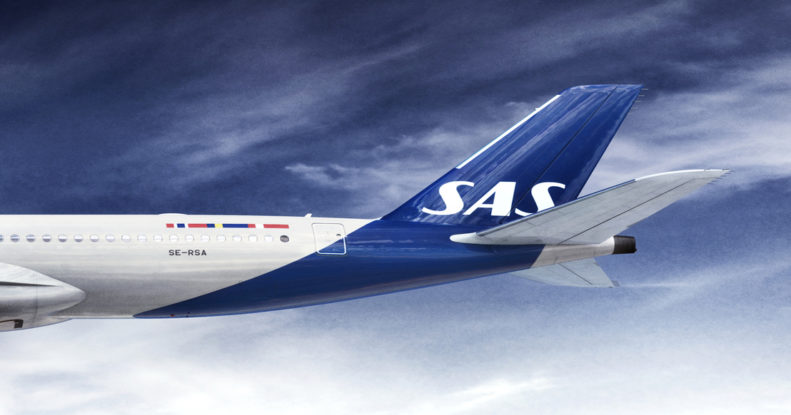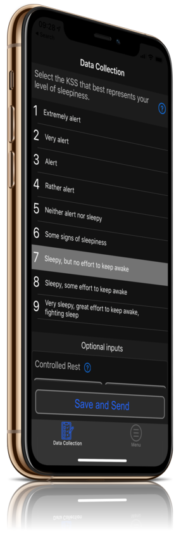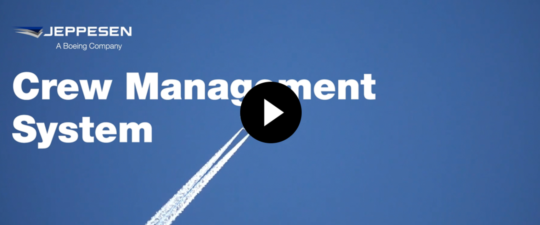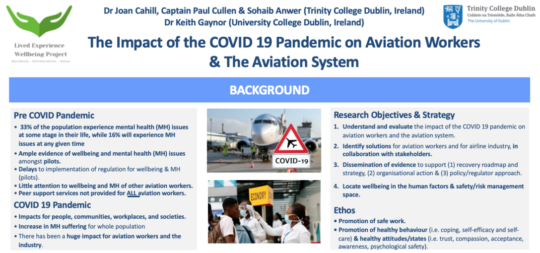
FRM News Flash – September 2020
From Monthly to Weekly. Quickly.
Scandinavian Airlines (SAS), has encountered severe crew planning challenges due to the impacts of COVID-19, just as many other airlines have. We asked Martin Hoffman, head of Operational Planning Optimization at SAS, to describe the challenges faced and the adjustments made to the airline’s planning processes.
What was the situation like for you, going into the early phase of the pandemic?
– In early March, we realized that the changes in the traffic program were going to be both severe and frequent for a long period ahead. We identified a need of quickly updating our crew process to plan and release rosters weekly, instead of monthly. It was also crucial to have the traffic program updated two weeks prior to the actual production, to be able to reflect the changes in various Covid-19-related restrictions given by each country, and also a very variable demand.
You managed to change your planning process in  just two weeks, how was that possible?
– The effort of changing the process was made easier for us by the production being only some 5% compared to normal – freeing up resources in the crew planning department. We also received support from Jeppesen in assisting us to convert some monthly rule limits into weekly etc. But even more importantly, I would say, it was that all the system changes could be done in the configuration layer of our solutions, rather than as updates to the core software. That was crucial and certainly cut our lead time a lot. The changes included updates to rescheduling rules, new process scripts and additional support for the training planning. We also implemented a number of updates to our crew agreements and process after negotiations with the unions.
And what does the process look like now?
– The traffic program is released every Monday for the period beginning on the Monday two weeks ahead. Crew pairing and rostering planning, using our optimizers, is done weekly and the crew receives their rosters one week prior to the first day of operation. All pre-assigned activities (locked days) are still released in the monthly roster release.
The outcome has been a process that provides us an ability to act at short notice as the Covid-19 situation develops, with borders either closing or opening and with passenger demand fluctuating. It also provided us an opportunity to reduce some administrative staff, using government-supported furlough options. We also continue to adjust, almost on a daily basis, as this situation is far from over. In fact, by the time you read this piece, our process may even have evolved beyond what I just described 😉
Thank you Martin for generously sharing these details. Many operators are in the same situation now, so we will see if we can get others to also share how they deal with their crewing process challenges.
Martin Hoffman is Head of Operational Planning Optimization at the Scandinavian airline SAS. SAS is the flag carrier of Denmark, Norway and Sweden. It is the eighth-largest airline in Europe, the largest in Denmark and Sweden, and has a fleet of 157 aircrafts Martin has been the COO for Long Haul Operations, Value Stream Owner for the Plan to Execution process, Head of Crew Planning and currently responsible for Operational Planning Optimization within SAS Group Operations.
just two weeks, how was that possible?
– The effort of changing the process was made easier for us by the production being only some 5% compared to normal – freeing up resources in the crew planning department. We also received support from Jeppesen in assisting us to convert some monthly rule limits into weekly etc. But even more importantly, I would say, it was that all the system changes could be done in the configuration layer of our solutions, rather than as updates to the core software. That was crucial and certainly cut our lead time a lot. The changes included updates to rescheduling rules, new process scripts and additional support for the training planning. We also implemented a number of updates to our crew agreements and process after negotiations with the unions.
And what does the process look like now?
– The traffic program is released every Monday for the period beginning on the Monday two weeks ahead. Crew pairing and rostering planning, using our optimizers, is done weekly and the crew receives their rosters one week prior to the first day of operation. All pre-assigned activities (locked days) are still released in the monthly roster release.
The outcome has been a process that provides us an ability to act at short notice as the Covid-19 situation develops, with borders either closing or opening and with passenger demand fluctuating. It also provided us an opportunity to reduce some administrative staff, using government-supported furlough options. We also continue to adjust, almost on a daily basis, as this situation is far from over. In fact, by the time you read this piece, our process may even have evolved beyond what I just described 😉
Thank you Martin for generously sharing these details. Many operators are in the same situation now, so we will see if we can get others to also share how they deal with their crewing process challenges.
Martin Hoffman is Head of Operational Planning Optimization at the Scandinavian airline SAS. SAS is the flag carrier of Denmark, Norway and Sweden. It is the eighth-largest airline in Europe, the largest in Denmark and Sweden, and has a fleet of 157 aircrafts Martin has been the COO for Long Haul Operations, Value Stream Owner for the Plan to Execution process, Head of Crew Planning and currently responsible for Operational Planning Optimization within SAS Group Operations.

CrewAlert TOD, the go-to app for iOS and Android when it comes to continuously measuring fatigue risk for flight operations far beyond what fatigue reporting allows for, just became even more powerful.

Already in the previous version, crew needed only a about 20 seconds per flight to score their sleepiness levels.
In our latest update, just made available for iOS, we’ve added Siri shortcuts. Crew can now log their sleepiness levels in an even faster and more convenient way via the native Siri voice commands on iPhone and iPad. As simple as this:
– Hey Siri, log sleepiness level seven.
The CrewAlert TOD app (TOD for ‘Top of Descent’) is available for free on both the Appstore and the Google Play store, but entities organising a data collection will need to provide crew with their user account information. In case you represent an airline operator, union, or even a regulator, and would like to know more about how to get up and running with a data collection using CrewAlert TOD, please contact us here. Welcome!
Links to CrewAlert TOD: Appstore, Google Play
Best-of-breed, or One Integrated Solution? Why Choose?

The Jeppesen crew management solutions have been considered, by many, as best-of-breed products with leading capabilities for optimization, flexibility and decision support. Less known, perhaps, is the power of the fully integrated suite of solutions to deliver a comprehensive Crew Management System (CMS). A CMS that breaks down silos in your operation, enabling more efficient workflow and amplifying collaboration across functional areas. Learn more about the Jeppesen crew management suite of solutions in this newly released video, and how an integrated CMS can benefit your operation and why it stands out from the crowd. Enjoy.
Welcome to read more about Jeppesen Crew Pairing, Rostering, Tracking, Manpower and Fatigue Risk Management here.
Impact of the Pandemic, Preliminary Findings

The survey by Trinity College Dublin, as highlighted in the last FRM News Flash, assessing the impact of the COVID-19 pandemic on aviation workers and flight safety has now closed. Over 2000 aviation workers participated, and a preliminary analysis has arrived at 9 high-level recommendations regarding the recovery roadmap. The recommendations includes proposing aviation organisations to strengthen their supports for crew wellbeing, as well as for regulators to address the timeline for introduction of new regulation for management of wellbeing aspects for safety-critical workers. Please find a poster of the preliminary findings via this link on their project homepage .
The research is performed by the ‘Lived Experience & Wellbeing Project’ team at the Centre for Innovative Human Systems (CIHS), Trinity College Dublin, Ireland.
Planning Cargo Operations, and “this too shall pass”
Calle Jershed is a well-known face for many of the  Jeppesen Crew Solution customers. In his communication/marketing role he has been involved in most of our crew conferences since he began back in 2006. As Calle will leave Jeppesen in October, to embark on new adventures within communication in the healthcare domain, we asked him to do one last interview for us. Calle chose to sit down with Mattias Lindqvist and Tomas Klemets to talk about cargo operations:
Jeppesen Crew Solution customers. In his communication/marketing role he has been involved in most of our crew conferences since he began back in 2006. As Calle will leave Jeppesen in October, to embark on new adventures within communication in the healthcare domain, we asked him to do one last interview for us. Calle chose to sit down with Mattias Lindqvist and Tomas Klemets to talk about cargo operations:
Mattias, we have recently seen quite a few Cargo operators begin to use the Jeppesen Crew Pairing solution, and also FRM, why is that?
– Cargo operations have historically been a challenging problem to solve and optimize efficiently. There are several complicating factors behind that. Cargo operators typically have complex networks that span across the globe which require long trips, augmented work duties and greater consideration to the fatigue risk for the pilots. They also have demand mechanisms that differ from passenger operators, in that the flight schedule is more volatile – leading to greater variation in the working patterns from one week to another, even day to day. The cargo aircrafts can also impose more limitations in terms of the amount of deadheading crew, and the operation often uses less frequented airports or terminals. This puts higher demand on ‘creativity’ in the positioning of crew, using other commercial carrier but also more ground transports like bus, train and taxi. Sometimes two, or even three, consecutive positioning flights or transports are necessary for producing efficient pairings. Recent research and development in the products enables us to address these factors significantly better than just a couple of years ago – both for smaller and really big operators. This recent development is, in my opinion, the main reason why we’ve seen operators appear in this News Flash such as Cathay, AirBridge Cargo, Lufthansa Cargo, Kalitta and I hope soon another US-based cargo operator.
Can you explain more about the improvements in the system?
– The algorithms for the deadhead search is one area that I would highlight. We can now import and use a vast number of electronic flight schedule information and other time tables, allowing for very accurately identifying the best transport options. Of course while considering all constraints and using pricing information for the itineraries. And this done very quickly, as it is used during the optimization in real-time. Other improvements relate to the augmentation algorithms, general performance improvements and the enhancements to BAM that Tomas works with.

Thank you Mattias. Tomas – what makes cargo operations special when it comes to the fatigue risk perspective? I know that many cargo operators also use BAM with the pairing optimizer.
– Several things. Different to normal point-to-point long haul operation, the cargo pilots have much more challenging time zone transitions. They often operate patterns where they cannot rely on previous experience – as the pairings often vary quite a bit from month to month. Flying with two pilots, they also cannot use controlled rest as a mitigation as there’s no cabin crew present to check up on them. In addition, cargo operation normally means more late changes to the flying program which makes it tougher for the crew to prepare.
So how does a fatigue model like BAM assist in producing better cargo pairings?
– In the same way actually as for other operators, actually. BAM is hooked in to the optimizer’s objective function and makes the optimizer experience a penalty when flights are predicted to be too fatiguing on the crew. The more fatiguing, the higher the penalty. This makes the optimizer avoid placing challenging flights in a poor context, as they would then be seen as ’expensive’. The result may be that a challenging flight is instead flown by crew from another base, or flown later into a pairing when crew are better acclimatized to cover it. It is all done automatically in runtime while the pairings are constructed and all other objectives are considered.
And the result of what you both said, if I got this right, is more efficient pairings but also lower fatigue risk? Mattias?
– Yes. Plus, normally a much shorter planning process. Many operators are coming from either a manual process or a process that involves several time-consuming sequential steps. Doing it all in one run, in just a few hours, saves lead time. It also saves effort that instead can be spent on ‘planning analytics’, evaluating and proposing modifications to the flight schedule.
Thanks. And now a question to you both. Mattias first, – is there any improvement potential remaining for these problems?
– There is! We can improve even more on performance and even further on the accuracy of ticket prices for the deadhead candidates. Ticket prices can, as you know, vary significantly over time and between operators, and the deadhead cost is often prevalent for these cargo operstors.
And for FRM, Tomas?
– Definitely! Fatigue prediction models sometimes struggle with these patterns. There is a shortage of data on how crew are sleeping and their experienced sleepiness levels, since these patterns look so different from time to time. The models can definitely become better. One example for is the prediction of acclimatization: models today rely too much on time zone difference, when in reality the timing of light exposure is what mainly drives the physiology. We are taking important steps regarding that in the next version of BAM, but there will be more to do in the future.
It was good talking to you both. Thank you.
[Mattias & Tomas] – Thank you Calle for your contributions here at Jeppesen and best of luck in your new role. You will be missed!
Thanks. And I would like to take the chance from my side to thank all the fantastic airline representatives I’ve met during my time here at Jeppesen. I wish you all the best, starting with pulling through the current pandemic. I’m certain that ‘this too shall pass‘ and that a prosperous and exciting future lies ahead for the industry. Take care, and hope to see you around!
Meet up with the Jeppesen experts
OCT 26 – Nov 06: Jeppesen Crew Connect 2020 (Users Conference), Online
OCT 29-31: Annual DGSM Meeting, Online
Many events continue to be cancelled or re-scheduled due to COVID-19. Please drop us an email here instead if you would like to schedule a call or a webex demo.
jeppesen.com/frm
+46 31 720 81 00
Send us an Email
If you aren’t receiving the FRM News Flash directly in your email inbox, sign up here.
From Monthly to Weekly. Quickly.
Scandinavian Airlines (SAS), has encountered severe crew planning challenges due to the impacts of COVID-19, just as many other airlines have. We asked Martin Hoffman, head of Operational Planning Optimization at SAS, to describe the challenges faced and the adjustments made to the airline’s planning processes.
What was the situation like for you, going into the early phase of the pandemic?
– In early March, we realized that the changes in the traffic program were going to be both severe and frequent for a long period ahead. We identified a need of quickly updating our crew process to plan and release rosters weekly, instead of monthly. It was also crucial to have the traffic program updated two weeks prior to the actual production, to be able to reflect the changes in various Covid-19-related restrictions given by each country, and also a very variable demand.
You managed to change your planning process in  just two weeks, how was that possible?
just two weeks, how was that possible?
 just two weeks, how was that possible?
just two weeks, how was that possible?– The effort of changing the process was made easier for us by the production being only some 5% compared to normal – freeing up resources in the crew planning department. We also received support from Jeppesen in assisting us to convert some monthly rule limits into weekly etc. But even more importantly, I would say, it was that all the system changes could be done in the configuration layer of our solutions, rather than as updates to the core software. That was crucial and certainly cut our lead time a lot. The changes included updates to rescheduling rules, new process scripts and additional support for the training planning. We also implemented a number of updates to our crew agreements and process after negotiations with the unions.
And what does the process look like now?
– The traffic program is released every Monday for the period beginning on the Monday two weeks ahead. Crew pairing and rostering planning, using our optimizers, is done weekly and the crew receives their rosters one week prior to the first day of operation. All pre-assigned activities (locked days) are still released in the monthly roster release.
The outcome has been a process that provides us an ability to act at short notice as the Covid-19 situation develops, with borders either closing or opening and with passenger demand fluctuating. It also provided us an opportunity to reduce some administrative staff, using government-supported furlough options. We also continue to adjust, almost on a daily basis, as this situation is far from over. In fact, by the time you read this piece, our process may even have evolved beyond what I just described 😉
Thank you Martin for generously sharing these details. Many operators are in the same situation now, so we will see if we can get others to also share how they deal with their crewing process challenges.
Martin Hoffman is Head of Operational Planning Optimization at the Scandinavian airline SAS. SAS is the flag carrier of Denmark, Norway and Sweden. It is the eighth-largest airline in Europe, the largest in Denmark and Sweden, and has a fleet of 157 aircrafts Martin has been the COO for Long Haul Operations, Value Stream Owner for the Plan to Execution process, Head of Crew Planning and currently responsible for Operational Planning Optimization within SAS Group Operations.

CrewAlert TOD, the go-to app for iOS and Android when it comes to continuously measuring fatigue risk for flight operations far beyond what fatigue reporting allows for, just became even more powerful.

Already in the previous version, crew needed only a about 20 seconds per flight to score their sleepiness levels.
In our latest update, just made available for iOS, we’ve added Siri shortcuts. Crew can now log their sleepiness levels in an even faster and more convenient way via the native Siri voice commands on iPhone and iPad. As simple as this:
– Hey Siri, log sleepiness level seven.
The CrewAlert TOD app (TOD for ‘Top of Descent’) is available for free on both the Appstore and the Google Play store, but entities organising a data collection will need to provide crew with their user account information. In case you represent an airline operator, union, or even a regulator, and would like to know more about how to get up and running with a data collection using CrewAlert TOD, please contact us here. Welcome!
Links to CrewAlert TOD: Appstore, Google Play
Best-of-breed, or One Integrated Solution? Why Choose?

The Jeppesen crew management solutions have been considered, by many, as best-of-breed products with leading capabilities for optimization, flexibility and decision support. Less known, perhaps, is the power of the fully integrated suite of solutions to deliver a comprehensive Crew Management System (CMS). A CMS that breaks down silos in your operation, enabling more efficient workflow and amplifying collaboration across functional areas. Learn more about the Jeppesen crew management suite of solutions in this newly released video, and how an integrated CMS can benefit your operation and why it stands out from the crowd. Enjoy.
Welcome to read more about Jeppesen Crew Pairing, Rostering, Tracking, Manpower and Fatigue Risk Management here.
Impact of the Pandemic, Preliminary Findings

The survey by Trinity College Dublin, as highlighted in the last FRM News Flash, assessing the impact of the COVID-19 pandemic on aviation workers and flight safety has now closed. Over 2000 aviation workers participated, and a preliminary analysis has arrived at 9 high-level recommendations regarding the recovery roadmap. The recommendations includes proposing aviation organisations to strengthen their supports for crew wellbeing, as well as for regulators to address the timeline for introduction of new regulation for management of wellbeing aspects for safety-critical workers. Please find a poster of the preliminary findings via this link on their project homepage .
The research is performed by the ‘Lived Experience & Wellbeing Project’ team at the Centre for Innovative Human Systems (CIHS), Trinity College Dublin, Ireland.
Planning Cargo Operations, and “this too shall pass”
Calle Jershed is a well-known face for many of the  Jeppesen Crew Solution customers. In his communication/marketing role he has been involved in most of our crew conferences since he began back in 2006. As Calle will leave Jeppesen in October, to embark on new adventures within communication in the healthcare domain, we asked him to do one last interview for us. Calle chose to sit down with Mattias Lindqvist and Tomas Klemets to talk about cargo operations:
Jeppesen Crew Solution customers. In his communication/marketing role he has been involved in most of our crew conferences since he began back in 2006. As Calle will leave Jeppesen in October, to embark on new adventures within communication in the healthcare domain, we asked him to do one last interview for us. Calle chose to sit down with Mattias Lindqvist and Tomas Klemets to talk about cargo operations:
 Jeppesen Crew Solution customers. In his communication/marketing role he has been involved in most of our crew conferences since he began back in 2006. As Calle will leave Jeppesen in October, to embark on new adventures within communication in the healthcare domain, we asked him to do one last interview for us. Calle chose to sit down with Mattias Lindqvist and Tomas Klemets to talk about cargo operations:
Jeppesen Crew Solution customers. In his communication/marketing role he has been involved in most of our crew conferences since he began back in 2006. As Calle will leave Jeppesen in October, to embark on new adventures within communication in the healthcare domain, we asked him to do one last interview for us. Calle chose to sit down with Mattias Lindqvist and Tomas Klemets to talk about cargo operations:Mattias, we have recently seen quite a few Cargo operators begin to use the Jeppesen Crew Pairing solution, and also FRM, why is that?
– Cargo operations have historically been a challenging problem to solve and optimize efficiently. There are several complicating factors behind that. Cargo operators typically have complex networks that span across the globe which require long trips, augmented work duties and greater consideration to the fatigue risk for the pilots. They also have demand mechanisms that differ from passenger operators, in that the flight schedule is more volatile – leading to greater variation in the working patterns from one week to another, even day to day. The cargo aircrafts can also impose more limitations in terms of the amount of deadheading crew, and the operation often uses less frequented airports or terminals. This puts higher demand on ‘creativity’ in the positioning of crew, using other commercial carrier but also more ground transports like bus, train and taxi. Sometimes two, or even three, consecutive positioning flights or transports are necessary for producing efficient pairings. Recent research and development in the products enables us to address these factors significantly better than just a couple of years ago – both for smaller and really big operators. This recent development is, in my opinion, the main reason why we’ve seen operators appear in this News Flash such as Cathay, AirBridge Cargo, Lufthansa Cargo, Kalitta and I hope soon another US-based cargo operator.
Can you explain more about the improvements in the system?
– The algorithms for the deadhead search is one area that I would highlight. We can now import and use a vast number of electronic flight schedule information and other time tables, allowing for very accurately identifying the best transport options. Of course while considering all constraints and using pricing information for the itineraries. And this done very quickly, as it is used during the optimization in real-time. Other improvements relate to the augmentation algorithms, general performance improvements and the enhancements to BAM that Tomas works with.

Thank you Mattias. Tomas – what makes cargo operations special when it comes to the fatigue risk perspective? I know that many cargo operators also use BAM with the pairing optimizer.
– Several things. Different to normal point-to-point long haul operation, the cargo pilots have much more challenging time zone transitions. They often operate patterns where they cannot rely on previous experience – as the pairings often vary quite a bit from month to month. Flying with two pilots, they also cannot use controlled rest as a mitigation as there’s no cabin crew present to check up on them. In addition, cargo operation normally means more late changes to the flying program which makes it tougher for the crew to prepare.
So how does a fatigue model like BAM assist in producing better cargo pairings?
– In the same way actually as for other operators, actually. BAM is hooked in to the optimizer’s objective function and makes the optimizer experience a penalty when flights are predicted to be too fatiguing on the crew. The more fatiguing, the higher the penalty. This makes the optimizer avoid placing challenging flights in a poor context, as they would then be seen as ’expensive’. The result may be that a challenging flight is instead flown by crew from another base, or flown later into a pairing when crew are better acclimatized to cover it. It is all done automatically in runtime while the pairings are constructed and all other objectives are considered.
And the result of what you both said, if I got this right, is more efficient pairings but also lower fatigue risk? Mattias?
– Yes. Plus, normally a much shorter planning process. Many operators are coming from either a manual process or a process that involves several time-consuming sequential steps. Doing it all in one run, in just a few hours, saves lead time. It also saves effort that instead can be spent on ‘planning analytics’, evaluating and proposing modifications to the flight schedule.
Thanks. And now a question to you both. Mattias first, – is there any improvement potential remaining for these problems?
– There is! We can improve even more on performance and even further on the accuracy of ticket prices for the deadhead candidates. Ticket prices can, as you know, vary significantly over time and between operators, and the deadhead cost is often prevalent for these cargo operstors.
And for FRM, Tomas?
– Definitely! Fatigue prediction models sometimes struggle with these patterns. There is a shortage of data on how crew are sleeping and their experienced sleepiness levels, since these patterns look so different from time to time. The models can definitely become better. One example for is the prediction of acclimatization: models today rely too much on time zone difference, when in reality the timing of light exposure is what mainly drives the physiology. We are taking important steps regarding that in the next version of BAM, but there will be more to do in the future.
It was good talking to you both. Thank you.
[Mattias & Tomas] – Thank you Calle for your contributions here at Jeppesen and best of luck in your new role. You will be missed!
Thanks. And I would like to take the chance from my side to thank all the fantastic airline representatives I’ve met during my time here at Jeppesen. I wish you all the best, starting with pulling through the current pandemic. I’m certain that ‘this too shall pass‘ and that a prosperous and exciting future lies ahead for the industry. Take care, and hope to see you around!
Meet up with the Jeppesen experts
OCT 26 – Nov 06: Jeppesen Crew Connect 2020 (Users Conference), Online
OCT 29-31: Annual DGSM Meeting, Online
Many events continue to be cancelled or re-scheduled due to COVID-19. Please drop us an email here instead if you would like to schedule a call or a webex demo.
| jeppesen.com/frm | +46 31 720 81 00 | Send us an Email |
If you aren’t receiving the FRM News Flash directly in your email inbox, sign up here.
